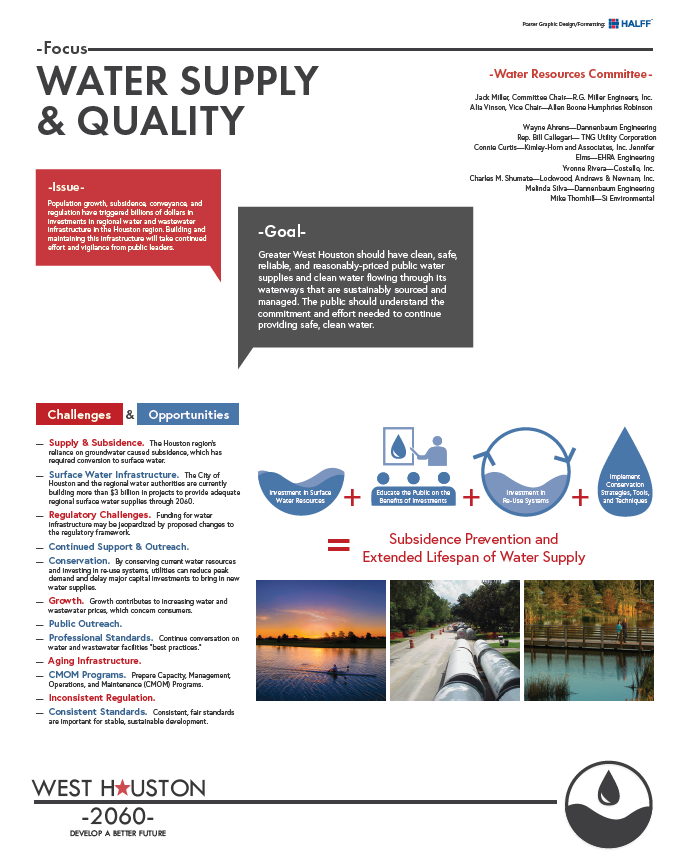Water Supply & Quality in 2060
We have just published our West Houston 2060 Plan and in it we tackle some of the challenges and opportunities the region may face when reaching the year 2060. Below is the committee’s event board which gives an overview of the plan section, but click the title above to view the entire committee section and for a complete version of the 2060 plan.
WHA SUPPORTS PASSAGE OF PROP 6, THE CONSTITUTIONAL AMENDMENT FUNDING THE TEXAS WATER PLAN
The West Houston Association Board of Directors resolved to support the passage of the Constitutional Amendment, Proposition 6 which will authorize $2 billion to be transfer from the Texas Rainy Day Fund to finance the Texas Water Plan. The Board urges its members to seriously consider the very strong facts regarding our state’s fresh water supply problem and the proposal from the Texas Legislature which appears on the November 6th Constitutional Amendment ballot to transfer $2 billion from the Rainy Day Fund to fund the Texas Water Plan. We believe this is an excellent proposal and deserves your full attention and support. Below the Board presents its resolution on the matter.
| West HoustonAssociation
Board of Directors |
ResolutionSupporting Passage
Of Prop 6: Funding The Texas Water Plan |
WHEREAS, Texas’ population, which is expected to nearly double to 46 million by 2060, and related economic expansion and jobs are jeopardized by dwindling fresh water supplies; and
WHEREAS, conservation and reuse strategies, while required, will not alone meet the demand resulting from this considerable growth; and
WHEREAS, current water resources are persistently threatened by ongoing droughts and may not adequately support current population let alone future growth; and
WHEREAS, the Texas Legislature has passed legislation that will provide critical funding for the State’s Water Plan by transferring $2 billion from the State’s Rainy Day Fund and has put the matter before the voters of Texas as Proposition 6 on the November, 2013 constitutional amendment ballot; and
WHEREAS, the proposal is based upon a specific plan to secure our long range water needs, allows local control by water districts and cities to determine water projects and oversee how the funding is spent, and does not raise taxes on citizens of Texas;
BE IT HEREBY RESOLVED that the Board of Directors of the West Houston Association supports passage of Proposition 6 and urges its individual members to vote in support of Proposition 6.
Passed this 3rd day of October, 2013.
GREATER WEST HOUSTON’S WATER & WASTEWATER INFRASTRUCTURE IS KEY TO A GROWING AREA
The West Houston Association advocates aggressively for first class new and rebuilt water and wastewater systems that meet the needs of a growing Greater West Houston.
Water Supply: Water for an expanding GWH is critical. Sufficient supplies are available to serve current and future demand to 2060 assuming completion of the Allen’s Creek Reservoir. In addition, this anticipates the completion of major distribution facilities that will move surface water from the Trinity River to GWH. Water authorities in the west and north of the region and municipalities are facilitating conversion to surface supplies and expanding distribution networks. New developments should deploy conservation techniques.
Wastewater Quality & Regionalization: Stream quality will have to be maintained and/or improved to meet ever increasing water quality regulations. The effluent quality of wastewater treatment plants is subject to state and local permitting and inspection. If facilities are found to be discharging below standard effluent, existing remedies can be employed by regulators to bring them into compliance. Regionalization of treatment facilities in developing areas will cause significant cost burdens with little or no increase in efficiencies and effluent quality. In fact, regionalization will work against the deployment of conservation techniques such as water reuse.
SUBSIDENCE
(Reprinted from Community Impact Newspaper Marie Leonard June 15, 2012)
Water districts try to rebound after 2011’s drought conditions
Although the Harris-Galveston Subsidence District met its 2010 deadline to reduce by 30 percent dependency on groundwater in north and west Harris County, 70 percent of the area must be supplied with surface water by 2020. During last summer’s drought, the HGSD saw a slight flip-flop in the benefits from the previous conversions, as more users switched back to groundwater, said Tom Michel, deputy general manager for the HGSD. The change happened because of the high demand for both surface water, which comes from creeks and lakes, and groundwater, which is pumped from underground aquifers. “It was definitely a test of the system, and we had some challenges, but everyone made it through unscathed,” Michel said. “If we had an extended drought, it would pose some issues, because the reservoirs wouldn’t have time to refill.”
Subsidence
The earliest signs of subsidence—sinking caused by too much groundwater pumping—became most apparent by the ’60s and ’70s when the economic boom began in Houston. “A lot of industry was coming, along with all the people who supported that,” Michel said. “The demand for water was increasing rapidly, mostly in the coastal areas.”
The district addressed the problem where it was worst first, before moving inland to deal with the rest of the county. In Northwest Houston, the epicenter of subsidence has been roughly around the Jersey Village area, Michel said.
“Typically there will be a small amount of natural subsidence, because the ground will settle,” he said. “You could maybe expect to see half a foot to a foot every 100-plus years, whereas you look back over the past 100 years [around Jersey Village] and you see seven-plus feet of subsidence.”
A monitoring site at FM 1960 and Hwy. 290 has measured nearly 20 inches of subsidence since 1996, according to the HGSD. Even sites farther west in Cypress such as Skinner Road at Hwy. 290 have measured almost 10 inches since 2000.
Conversion process
The West Harris County Water Authority, which oversees the area west of Hwy. 290, has an agreement with the City of Houston and other water authorities in the area to fund the Luce Bayou Project, which will transfer 400 million gallons of surface water daily from the Trinity River via Luce Bayou to Lake Houston as a future water supply.
In addition, the authority has partnered with the Northern Fort Bend Water Authority to construct and design a large diameter transmission to transfer water from the City of Houston’s northeast water treatment plant across town to western Harris County.The 2020 conversion is expected to cost $750 million to $1 billion, and it will be funded through user fees and a $42 million infrastructure loan from the Texas Water Development Board, said Wayne Ahrens, program manager for the WHCRWA.
Several communities in Cypress, including Towne Lake, Bridgeland and Cypress Creek Lakes, will be converted to surface water by the end of the year. In addition to a monthly water bill based on usage, residents in those communities under the WHCRWA pay a pumpage fee of $1.75 per 1,000 gallons, but they will pay a surface fee of $2.50 per 1,000 gallons when the conversion is complete. The North Harris County Regional Water Authority, which oversees the area east of Hwy. 290, has a groundwater fee of $1.75 per 1,000 gallons, and its surface water fee is $2.20 per 1,000 gallons
“The people in west Harris County are affected because they need to change how they use their water,” said state Rep. Bill Callegari, R-Katy. “As we move forward it will cost more, and they’ve seen that already.”
Conservation issues
As the Houston area begins to rely more heavily on surface water, there needs to be an adequate source of water from lakes, Callegari said.“[Using a lot of surface water] does strain those resources, so we do need to be conscientious,” he said. “We need to plant grasses and shrubs that will use less water, and we basically need to learn to self-ration.”
The City of Jersey Village will propose a plan as part of its 2012–13 budget to use its treated sewer water to irrigate the city golf course. Construction estimates are about $150,000–$200,000 to build the proper sewer lines, but the irrigation would be exempt from the NHCRWA fees, said Mike Castro, city manager.
“From a conservation standpoint, the golf course relies on groundwater wells, and since we have subsidence issues, the more we can get off groundwater wells, the better,” he said.
There are two reservoirs in Harris County that supply the area with its drinking water, but more people in the state need to realize there is a need for new facilities, Callegari said.
The Texas Legislature designated 22 future sites around the state on which to build reservoirs, but there are none planned for Harris County. Located in Austin County, the proposed Allens Creek Reservoir will provide water to the Houston area. Although plans have been in the works since the ’80s, construction is not expected to begin until 2018.
“It’s an issue of if you build it, will they come? Most people won’t commit to purchasing water until they know they need it,” Callegari said.

